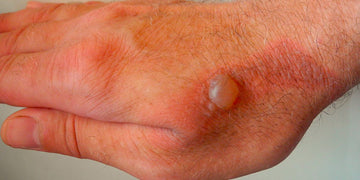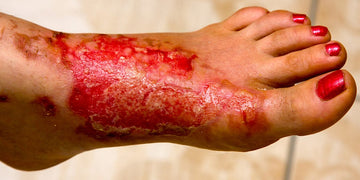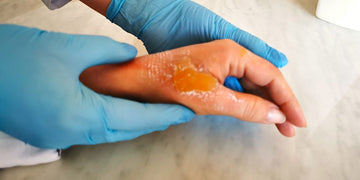First-degree burns do not require medical treatment. They are superficial, meaning they have not damaged the second layer of skin. This is a good thing because blisters form to protect deeper layers of skin from infection and to act as a water-buffer system. This means healing first-degree burns is easy and quick, and they do not need to be covered. 
What is a First-Degree Burn?
A first-degree burn is a minor burn. These types of skin burns affect only the outer layer of the skin or epidermis. First-degree burn symptoms include redness, swelling, and pain. If you have a first-degree burn, it’s usually minor and heals in about a week without scarring.
A first-degree burn doesn’t destroy any skin tissue. The top layer of your skin, the epidermis, is damaged and turns red. The area may also feel warm and painful to the touch.
The epidermis doesn’t have blood vessels or nerve endings, so it can’t feel pain. But when you injure the top layer of skin cells, they release substances that make your body respond as if there’s been damage to deeper tissues. This causes your blood vessels to dilate (widen), sending more blood to the area and making it appear red or pinkish in color.
Healing first-degree burns within a few days without scarring or leaving permanent damage is most often the likely outcome.
What are Common Causes of First-Degree Burns?
Most first-degree burns are caused by contact with hot surfaces — such as from touching a stovetop (scald) or walking barefoot on hot pavement — or prolonged exposure to sunlight without sunscreen protection (sunburn). You might also get them from friction caused by rubbing against rough surfaces, such as carpeting, that’s had a lot of wear and tear over time.
Should a First-degree Burn be Covered?
If you have a first-degree burn, it’s best to leave it uncovered until it has healed. You might want to put antibiotic cream on the wound, but don’t cover it up with bandages or creams that contain alcohol or other chemicals that can irritate your skin further.
If your burn is more than 2 inches (5 cm) across, or if you have several smaller burns close together, see your doctor as soon as possible so they can assess whether they need further treatment.
How long do first-degree burns take to heal?
How long it takes for a first-degree burn to heal depends on its size and the severity of the injury. Smaller burns often heal within days. Larger ones can take weeks or even months.
What should you not do for a first-degree burn?
What not to do with a first-degree burn is just as crucial as what you should do:
- Don’t break open blisters — This is one of the worst things people do when they have a first-degree burn on their hands or feet. If you have a blister on your foot or hand, don’t pop it! It won’t help the pain go away faster and could lead to infection if germs enter the blister cavity.
- Don’t apply butter, grease, greasy ointments, or other substances to the burn.
- Try not to touch the burned area if possible.
- Give aspirin or ibuprofen to your child unless he has been prescribed these medications by his doctor. These medications can make him bleed more easily if he gets injured during treatment.
How do doctors treat first-degree burns?
If the burn covers more than 1 percent of your body (about 3 square inches), you may need antibiotics to prevent infection. Your doctor will probably prescribe them if:
- The burn is larger than 3 inches across (about 7 centimeters).
- You have second-degree burns and not first-degree burns.
- The burn is on your hands or feet.
What is the fastest way to heal a first-degree burn?
The fastest way to heal a first-degree burn is to immediately put it in cold water. The next step is to take an over-the-counter pain reliever, such as acetaminophen. If you have a blister form, do not break it. A blister is fluid-filled and protects the skin from further damage. Blisters can form within hours of the burn. If you break the blister(s), it can prolong your healing process. 
Following this first-degree burn treatment is easy and essential for healthy healing. Keep an eye on the area while treating first-degree burns. If you notice any out-of-the-ordinary signs, consult a medical professional. 
Should I cover a burn at night?
Covering a first-degree burn at night is optional, depending on its seriousness. If you have other injuries that need care, covering your burn may help prevent further contamination during sleep by dirt or insect bites. Also, if you are far too uncomfortable to sleep with it uncovered, you can cover it. 
What does a first-degree burn look like?
A first-degree burn usually appears as a mild redness. The skin may feel warm and tender to the touch. Blisters may form, but they’ll be flat, thin, and fragile. These blisters can’t be spread or picked at, so they don’t need to be covered with a dressing. In some cases, there may also be swelling and pain.
Which ointment is best for first-degree burn wounds?
Use antibacterial ointment on small first-degree burns to prevent infection and promote healing. After cleaning any debris from your burn with water, people would commonly apply a non-stinging antibacterial ointment such as Neosporin or Polysporin, according to package directions. However, Vitastem Ultra is a much more effective burn treatment.
Is Vaseline good for first-degree burns?
Vaseline is an emollient that softens and protects skin by reducing water loss from the skin’s surface. It also has a soothing effect on irritated skin.
Vaseline can be used to protect against minor burns. It will help prevent infection and reduce pain and swelling.
How long should you keep a burn covered?
A first-degree burn does not need to be covered. If blisters form, seek medical attention. Otherwise, the only time you may want to cover a first-degree burn is for comfort while sleeping. 
How do you clean a first-degree burn at home?
To clean an uncomplicated first-degree burn:
Cool the area immediately by running cool water over it for 10 minutes or longer if possible. Cooling helps prevent infection by reducing inflammation (redness) and preventing bacteria from entering the wound site.
Apply an antibiotic ointment, such as bacitracin (Bactroban) which is the active ingredient used in Vitastem Ultra, on top of gauze pads that are then covered with an adhesive bandage to protect the wound from infection until it heals completely (typically within one week).
Consider Using Vitastem For Treating First-Degree Burns
Vitastem Ultra provides healing and relief to burns of first, second, and three-degree degrees at speed ten times faster (12 hours versus 5 to seven days for most other products). The active ingredient, tetracycline, is fast and effective in eliminating all bacteria from the area. Thousands of bacteria types can be found in the human body. While most are harmless under normal conditions, they can become pathogens in wounded tissue. Vitastem Ultra’s dual-carrier action quickly takes the active ingredient deep within the injury, restoring damaged tissue more quickly and thoroughly.
Vitastem Ultra has a unique combination of ingredients that have made it possible for medicine to be transported at 10x greater strength and depth than the other products currently on the market. This formula stimulates cells in the skin to allow for 10x more medicine to penetrate into cells. Any harmful bacteria is overwhelmed and killed quickly, so it doesn’t have time to adapt or develop resistance. Vitastem Ultra, a highly concentrated, rapid delivery of medicine at the site of greatest need, has led to many patients experiencing such rapid results.
Vitastem Ultra, which kills bacteria, infuses skin cells damaged by infection with vitamin D3 & vitamin C (ascorbic). The skin is then left fully treated and rejuvenated. If you have a first-degree burn, or other burn(s) that require healing, ask your doctor about Vitastem Ultra to see if it’s a good burn treatment for your first-degree burn today.







